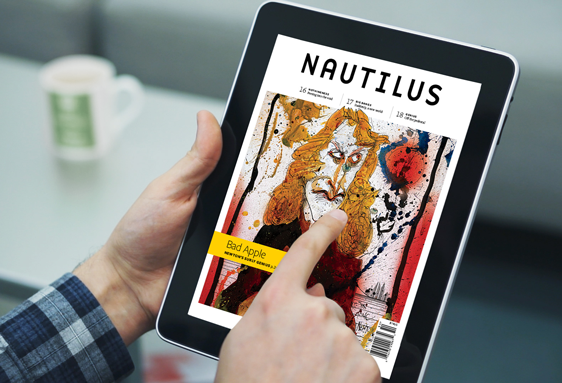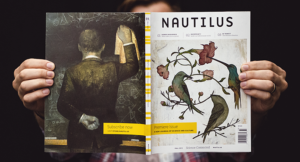A seasoned journalist rethinks science storytelling with Nautilus, a literary digital and print publication that explores science, philosophy, and culture.
 In an era where print magazines regularly go digital instead — or go under altogether — you might not expect a magazine to be able to go the other direction, from digital to print. But Nautilus, the science magazine launched in 2013 with a $5 million grant from the John Templeton Foundation, is an extraordinary case.
In an era where print magazines regularly go digital instead — or go under altogether — you might not expect a magazine to be able to go the other direction, from digital to print. But Nautilus, the science magazine launched in 2013 with a $5 million grant from the John Templeton Foundation, is an extraordinary case.
John Steele, the magazine’s founder, had spent 40 years in broadcast news, but wanted to move away from the sensational, reductionist status quo of popular science journalism — the variety that informs us that coffee is bad for us one day and a panacea the next. But he also had to find a way to keep readers engaged with topics that can be technically daunting — even people trained in one discipline of science can struggle to understand cutting-edge work in another field.
His solution relies on one core principle: “If you really want to grab somebody, if you really want to engage them, just tell them a good story,” says Steele.
In 2014, the magazine surveyed its readers to learn why they read Nautilus. One respondent sent the following comment: “Nowadays, science writing has lost its sense of story because the straight facts have no room for wonder and awe, supposedly.”
Nautilus thrives on the premise that science storytelling should be different. Never before have we been able to glimpse more wonderful things, and never have there been so many awe-inspiring stories to tell. The Nautilus team aims to foster curiosity by telling those stories and featuring contrarian points of view that might not receive coverage in mainstream science publications.
Beautiful Design, Deep Storytelling
 The success of the digital magazine spawned a print publication, and both versions have received numerous accolades. The website and the print publication each won a National Magazine Award, the highest honor in the world of longform writing. In the magazine’s first four years of publication, five Nautilus articles were featured in The Best American Science and Nature Writing anthology. Webby awards have rolled in. Recognition for its design abounds.
The success of the digital magazine spawned a print publication, and both versions have received numerous accolades. The website and the print publication each won a National Magazine Award, the highest honor in the world of longform writing. In the magazine’s first four years of publication, five Nautilus articles were featured in The Best American Science and Nature Writing anthology. Webby awards have rolled in. Recognition for its design abounds.
All of this success has been earned without one of the central trappings of modern media. “We’re not chasing clicks. It’s not who we are,” Steele says. Traffic might not be the goal, but the publication attracts a large, engaged audience. More than 750,000 people visit the Nautilus website every month.
More gratifying to Steele than massive reader numbers are humble letters like the one from a young reader named Kevin: “As a 19-year-old who is really trying to figure out how to positively impact the world around me as much as I can, it’s very helpful to have some insightful direction. … Everyone behind this project has my gratitude, as I’m sure what I read will inspire, as well as enlighten me, and will cause me to pursue far more in my life than I would have otherwise.”
“Google Analytics,” Steele says, “doesn’t tell you that.”